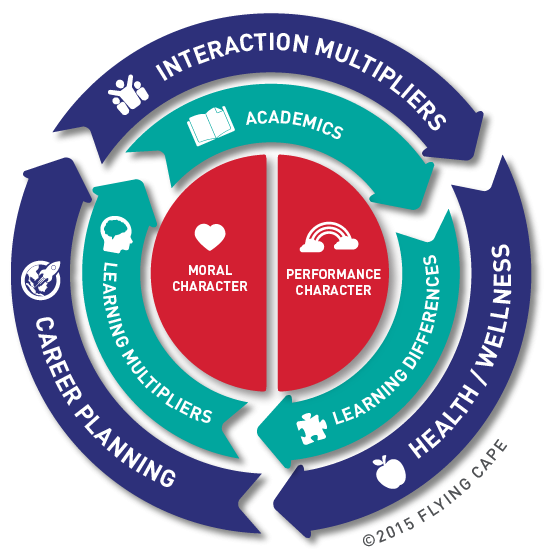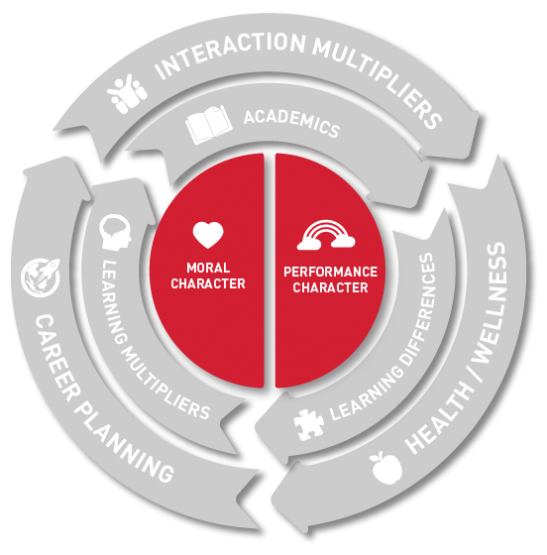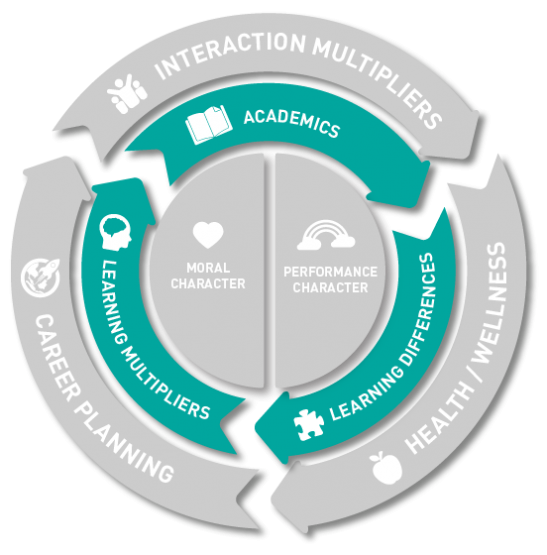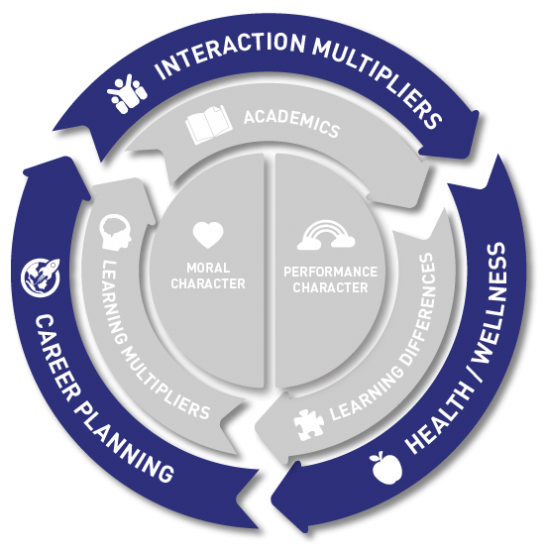Every parent hopes that they can raise a healthy, happy and well-adjusted child that will grow up to become successful in the real world. However, if doing well in school alone can no longer guarantee this success, what more should be done?
Educators now agree that the best bet in preparing any child for a fast-changing world is to equip him/her with a holistic education that can not only maximise their unique strengths and interests but to also ensure they can efficiently adapt and make the right choices where the situation arises.
Aligned with, the Singapore Ministry of Education’s 21st-century core competency framework, Flying Cape’s CompassMap seeks to provide a diagrammatic view of the key components of holistic education. It also provides a set of tools to help parents craft a personalised and effective learning path to holistic education for their children.
CompassMap Overview
As shown in Figure 1, the Flying Cape’s CompassMap is represented by 3 major circles (we call them dimensions). Represented from inside to out (shown in figure 1), the 3 dimensions are grouped as follows:
- GROUP 1: Building Strong Character (RED)
- GROUP 2: Acquiring Skills and Knowledge (GREEN)
- GROUP 3: Applying Skills and Knowledge (BLUE)

Figure 1: CompassMap Overview
Key Dimensions and their Multipliers
GROUP 1: Building Strong Character (RED)
This group which is focused on building strong character and is made up of:

![]()
“Doing the right thing when no one is looking”
Moral Character is usually values driven and determines whether you make the right choices to be a good and contributing individual in the society.
They include characteristics such as:-
- Moral courage
- Integrity
- Fairness
- Kindness
- Patience
“Having the internal drivers to overcome challenges”
Performance Character refers to habits and/or dispositions that an individual uses to motivate themselves to overcome personal challenges and hardships.
They include characteristics such as:-
- Self-Control/Awareness
- Social Intelligence
- Adaptability
- Curiosity
- Self-Confidence.
GROUP 2: Acquiring Skills and Knowledge (GREEN)
This group is focused on learning new skills and picking up knowledge and is made up of:


“Develop numeracy, literacy, reasoning capabilities and general knowledge.”
In many countries, education is viewed as a core pillar to help build a strong society and country. As an individual, getting a good education can make a key difference in his/her future economic well-being. In Singapore, all students undergo a well structured and tested curriculum which includes subjects such as:-
- English
- Mother Tongue
- History
- Geography
- Science.

“Techniques on HOW we learn what we need to learn”.
Learning Multipliers refer to the various techniques that can be learned in order to make future learning easier. The effectiveness of techniques is determined by a child’s preferred learning style.
Some techniques are:-
- Speed Reading
- Mental Arithmetic
- Mind Mapping
*Learning Differences have been included in this dimension to cater for students that have various special needs in learning.
GROUP 3: Applying Skills and Knowledge (BLUE)
This group is focused on how an individual interacts and performs with people in both personal and professional settings. It comprises of:


“Applying knowledge and skills to real world related matters”
Career Planning acts as a bridge for students to understand various occupations before deciding the appropropiate career path to pursue.
Areas that can help to transform this knowledge into application include:
- Business Basics
- Entrepreneurship
- STEM
- Financial Literacy.
- Digital & Media Literacy

“Interaction skills to achieve personal and team objectives”
Interaction Multipliers are focused on mainly socials skills. Some examples are:
- Public Speaking
- Leadership
- Negotiation Skills.
As you can see from the diagram above,
- Each grouping/dimension consists of the main component (MORAL, ACADEMIC AND CAREER) and a has a corresponding MULTIPLIER (PERFORMANCE, LEARNING AND INTERACTION). Multipliers are simply techniques/personality traits that can be learned to help maximise how quickly and effectively we learn or apply what we learn to the world around us.
- Within each grouping, a circular arrow connects both main component or its multiplier. The circular arrow aims to demonstrate the mutually enhancing relationship between main component and multiplier. For example, in the dimension of GROUP 2: Acquiring Skills and Knowledge (GREEN), a picture smart child will find that mastery in mind mapping can enhance his recall ability in learning a particular subject which further boosts his confidence and interest in applying the mind mapping technique to other subjects in Academics.
It is important to stress that while there is a wide range of skills and knowledge that can be acquired in every dimension, not all skills must be learned to achieve real world success.
Instead, each child should base their learning and career path based on his/her individual strengths, interests and motivations.
